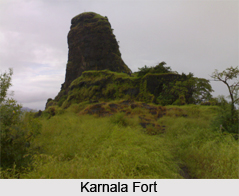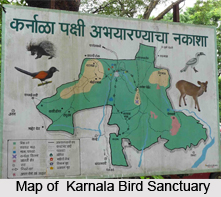 Karnala Fort is an ancient hill fort located in the district of Raigad in Maharashtra state. It is situated almost 10 km from the city of Panvel. The structure has immense strategic significance as it is situated at an altitude of 1,440 feet (439 m) and offers a panoramic view of the Bor pass. The geographical coordinates of the fort are latitude 18°52`54"N 73°07`05"E and longitude 18.881667°N 73.118056°E. The structure was primary built with stone. Karnala Fort was occupied by various ruling dynasties, such as, the Ahmednagar Sultanate, the Portuguese, the Maratha Empire and the British East India Company.
Karnala Fort is an ancient hill fort located in the district of Raigad in Maharashtra state. It is situated almost 10 km from the city of Panvel. The structure has immense strategic significance as it is situated at an altitude of 1,440 feet (439 m) and offers a panoramic view of the Bor pass. The geographical coordinates of the fort are latitude 18°52`54"N 73°07`05"E and longitude 18.881667°N 73.118056°E. The structure was primary built with stone. Karnala Fort was occupied by various ruling dynasties, such as, the Ahmednagar Sultanate, the Portuguese, the Maratha Empire and the British East India Company.
History of Karnala Fort
Karnala Fort was initially occupied by the Seuna Yadavas of Devagiri and Tughlaq dynasty. The region of Karnala served as the capital of the north Konkan districts of these respective empires. Later it was taken over by the Gujarat Sultanate. Eventually the fortress was occupied by the Nizam Shah of Ahmednagar in 1540. However, the structure was again conquered by the Gujarat sultans with the support of the Portuguese army under the command of Dom Francisco de Menenzes. It was then controlled by the Gujarat Sultanate but with Portuguese garrisons.
The Nizam Shah became angered after losing the fortress and thus attacked it with 5,000 soldiers. The Gujarat Sultans gave the control of the fort to the Portuguese and escaped to Vasai. The army of Nizam Shah was defeated by the Portuguese forces and the Karnala Fort remained under the control of the Portuguese. But later Karnala Fort and Sangli Fort were handed over to the Nizam Shah for an annual payment.

In the year 1670, Chatrapati Shivaji Maharaj of the Maratha Empire captured the fortress by defeating the Portuguese army. However, after the death of Shivaji in 1680, it was occupied by Mughal Emperor Aurangzeb. Later in 1740, the structure was conquered by the Peshwas of Pune. In the year 1818, Karnala Fort was attacked and seized by the army of the British East India Company under the command of Colonel Prother.
Architecture of Karnala Fort
The fort at Karnala comprises of two separate fortresses. One of the structures is located at a higher level and the other fort is situated in the lower level. There is a basalt pillar located at the centre of the higher level. It is around 125 feet in height and is known as Pandu`s tower. The structure was actually used as an observation tower to watch for enemy attacks. Presently this building is in a state of ruins. There is also a water reservoir in the premise that supplies fresh water throughout the year. The forts of Rajmachi and Prabalgad can be viewed from the summit.
Present Condition of Karnala Fort
Currently the entire Karnala Fort lies in a dilapidated and ruined condition. It is under the ownership of the Government of India. The site is open to visitors and attracts several tourists from across the across the country



















